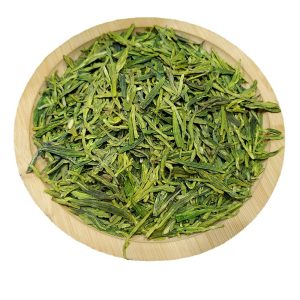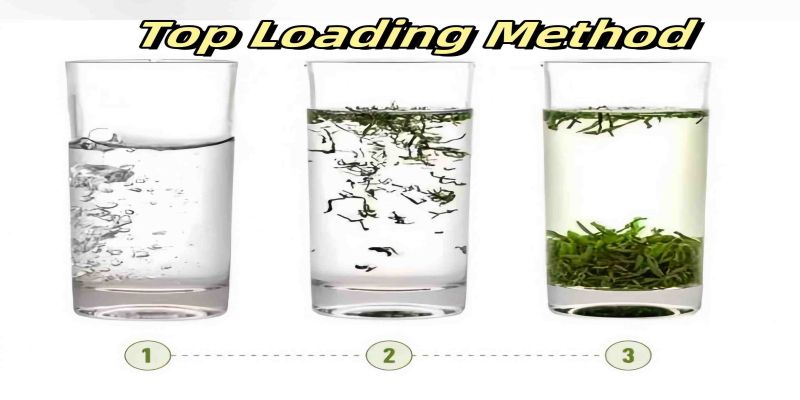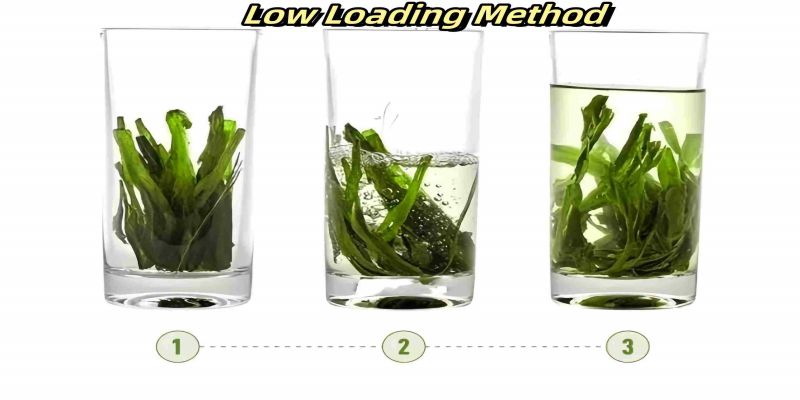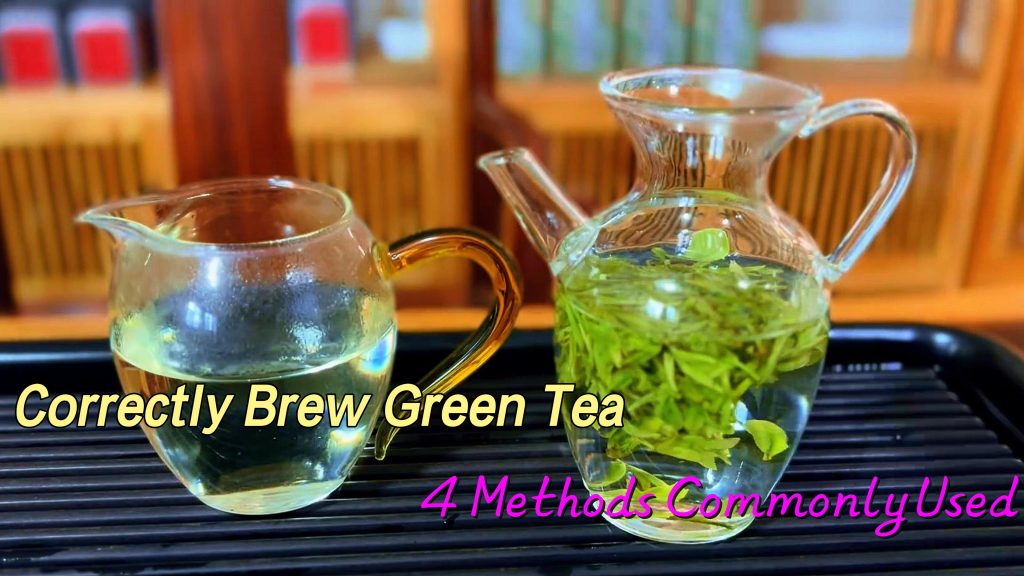Intro
Brewing green tea might seem simple, but did you know that the way you brew it can dramatically impact its flavor and aroma? Green tea is a delicate beverage, and even small variations in temperature or brewing technique can make the difference between a bitter cup and a refreshing, fragrant experience. This article will introduce 4 best ways about how to correctly and properly brew & steep green tea, how long to brew & steep green tea and what temperature to brew green tea.
Why You Should Correctly and Properly Brew Green Tea?
Brewing green tea might seem simple, but getting it right is crucial to ensuring that you capture its delicate and complex flavors and that you can learn how to brew green tea for maximum health benefits. Here are three key reasons why brewing green tea correctly makes all the difference:
1. Preserving Flavor and Aroma
Green tea is known for its fresh, subtle flavors and fragrant aroma. However, it’s also highly sensitive to water temperature and steeping time. If you brew green tea with water that’s too hot or steep it for too long, the tea can become bitter and astringent. By carefully controlling these factors, you preserve the tea’s natural sweetness and prevent overpowering bitterness, allowing the tea’s floral and grassy notes to shine.
2. Avoiding Nutrient Loss
Green tea is rich in antioxidants like catechins, which are responsible for many of its health benefits. However, brewing the tea incorrectly can degrade these beneficial compounds. For example, using excessively hot water can destroy some of these delicate antioxidants. By using the right temperature (90–95°C), you can ensure that the tea retains its nutritional value, offering both a delicious and healthful beverage.
3. Enhancing the Tea Experience
Correct brewing doesn’t just avoid mistakes—it also elevates the tea-drinking experience. Different brewing techniques can unlock various flavor profiles in the tea. For example, using a Gaiwan allows the leaves to expand and release complex, layered flavors, while glass pot brewing highlights the tea’s clarity and visual appeal. By mastering different methods, you not only enjoy the tea’s taste but also its aroma, appearance, and texture, making each sip a sensory experience.
By understanding and applying the correct brewing techniques, you ensure that every cup of green tea is as enjoyable and beneficial as possible, allowing you to fully appreciate its flavor, aroma, and health benefits.
Before we start to introduce the four methods of brewing green tea, to better evaluate each method’s effect, we use longjing green tea as the green tea for all four methods so as to better evaluate each method’s effects in evoking the green tea’s aroma.


Understand Three Basic Brewing & Steeping Techniques
Before formally introducing how to correctly brew longjing green tea for maximum health benefits, you have to understand the three techniques mostly commonly used in brewing green tea. In fact, when it comes to brewing green tea or other types of tea, there are three main techniques that influence the way the tea leaves release their flavor and aroma: top-loading (“上投法”), low-loading (“下投法”), and mid-loading (“中投法”). Each method is unique in how the tea leaves and water interact during the brewing process, and understanding these techniques can help you get the best flavor out of your tea.
1. Top-Loading Method

In the top-loading method, also known as “pouring water first,” you begin by filling the brewing or steeping vessel (such as a cup or pot) with hot water before adding the tea leaves.
- How it works: After adding the water (typically at 80–85°C for green tea), you sprinkle the tea leaves into the water from above. The tea leaves gradually sink to the bottom of the vessel as they infuse.
- Best for: This method is ideal for showcasing the freshness of the tea. Since the leaves slowly sink and unfurl in the water, it allows the tea to steep more gently and evenly, resulting in a lighter and more delicate flavor.
- Advantages: The gradual unfurling process releases the tea’s natural sweetness and highlights its fresh, floral notes. It also allows for a more visually appealing brewing process, as you can see the leaves slowly expand and settle in the water.
2. Mid Loading Method

The mid-loading method strikes a balance between the top-loading and low-loading techniques. With this method, you pour some hot water first, add the tea leaves, and then pour more water to complete the infusion.
- How it works: Start by filling the vessel with about 1/3 of the water. Add the tea leaves next, and gently swirl the cup or pot to help the leaves hydrate and begin to open up. Finally, pour the remaining hot water over the tea leaves.
- Best for: The mid-loading method is ideal for those who want a balanced flavor profile. It brings out both the freshness of the tea and the deeper flavors, making it a versatile method for brewing green tea.
- Advantages: This technique allows the tea to infuse gradually, ensuring an even extraction of flavors. It’s often used when time is limited but you still want a well-balanced cup of tea that highlights both freshness and aroma.
3. Low-Loading Method

In the low-loading method, or “adding tea leaves first,” the tea leaves are placed into the brewing vessel before the water is added.
- How it works: You begin by adding the tea leaves to the bottom of the gaiwan, cup, or pot. Then, hot water is gently poured over the leaves. This method is often used for denser, high-quality tea leaves that benefit from being fully submerged and awakened by the water.
- Best for: This technique is great for stronger, more robust teas, as it allows the tea leaves to infuse immediately. It’s often used for premium green teas or when you want to bring out a fuller, more intense flavor.
- Advantages: The low-loading method helps to release the tea’s deeper aromas and richer flavors more quickly, making it a perfect option for those who prefer a more concentrated and bold tea.
Method 1: Use Gaiwan to Brew Green Tea
The above video gives a detailed introduction of how to brew loose leaf green tea by using gaiwan tea set. Here is a breakdown of the key points of using gaiwan to brew green tea.
Key Highlights
- Tea vs Water Ratio: 1 gram of tea leaves for every 150 ml of water.
- At what water temperature to brew: 90–95°C.
- Brewing technique: Low-loading method (tea leaves are placed first).
- How long to brew: 30 seconds
Steps
- Place the tea leaves directly into the gaiwan.
- Pour a small amount of hot water over the leaves using a slow, gentle stream to rinse and awaken the leaves, allowing them to unfurl and release their aroma.
- Slowly add more water, ensuring the flow is steady and even, so the tea leaves float on the water’s surface.
- Let the tea steep for about 30 seconds, then pour into a cup and enjoy.
Evaluation
The Gaiwan method allows the tea leaves to release their full aroma and flavor, resulting in a bright golden liquor with a rich beany aroma and sweet, full-bodied taste. This method is ideal for those who enjoy savoring premium tea in a more formal setting, such as a tea ceremony, or when seeking a deeper, richer tea experience.
Best Suited For
This method is perfect for formal occasions, tea ceremonies, or when you want to take your time appreciating high-quality tea. It is especially suited for people who prefer a richer, more intense flavor
Method 2: Use Master Cup to Steep Green Tea
The above video gives a detailed guide of how to brew a cup of green tea properly by using Chinese master tea cup. Here is a breakdown of this method:
Key Highlights
- Tea & Water Ratio: 1 gram of tea leaves for every 100 ml of water.
- What temperature to brew: 80–85°C.
- Brewing technique: Mid-loading method (tea leaves added after some water).
- How long to brew: 1-2 minutes
Steps
- Preheat the Master Cup by rinsing it with hot water, then discard the water.
- Pour 1/3 of the hot water into the cup, then add the tea leaves.
- Gently swirl the cup to allow the tea leaves to hydrate and begin to open up.
- Slowly pour the rest of the hot water into the cup, ensuring the tea leaves roll and infuse evenly.
- Let the tea steep for 1–2 minutes before serving.
Evaluation
The tea brewed with the Master Cup method is fresh and aromatic, with a lighter concentration than the Gaiwan method. The fragrance is strong, and the tea retains a vibrant freshness. This method is excellent for quick brewing when entertaining guests or for those who prefer a lighter, more refreshing tea.
Best Suited For
This method is ideal for situations where time is limited but you still want to offer high-quality tea to guests. It’s great for quick tea preparation, especially for short visits or gatherings, where you want to serve tea efficiently without sacrificing taste.
Method 3: Use Glass Teapot to Brew Longjing Green Tea
The above video shows how to brew Chinese green tea properly by using glass teapots. Here is a list of this method’s key features:
Key Highlights
- Tea leaves ratio: 2 grams of tea leaves.
- How hot to brew: 80-85°C.
- Brewing technique: Mid-loading method
- How long should green tea brew: 3 minutes.
Steps
- Pour 1/3 of the hot water into the glass pot.
- Add 2 grams of tea leaves, then gently swirl the pot to help the tea leaves unfurl and release their aroma.
- Slowly add the remaining hot water, filling the pot up to the spout.
- Let the tea steep for about 3 minutes.
- Pour the tea into a fairness pitcher (Gong Dao Bei) to ensure an even distribution of flavor for all guests.
- Leave a small amount of tea at the bottom of the pot as a base for a second infusion.
Evaluation
This method is perfect for brewing a large quantity of tea, making it ideal for family gatherings or hosting multiple guests. The tea liquor is clear and golden, with a fresh, sweet flavor and moderate richness. It strikes a great balance between flavor and aroma, making it convenient and efficient for serving high-quality tea to many people.
Best Suited For
This method is best for large gatherings, family events, or when serving multiple people at once. It is particularly useful for occasions where you want to brew a large quantity of tea without compromising the quality
Method 4: Use Glass Tea Cup to Steep Green Tea
The above video shows how to brew green tea with tea bags by using glass tea cups. Here is a list of this method’s key features:
Key Highlights
- Tea & Water ratio: 1 gram of tea leaves for every 100 ml of water.
- What Is the Best Temperature to Brew: 80–85°C.
- Brewing technique: You can use either top-loading or mid-loading.
Steps
- Top-loading method: Pour the hot water into the glass cup first, then add the tea leaves. This method highlights the freshness of the tea.
- Mid-loading method: Pour 1/3 of the water, add the tea leaves, then gently swirl the cup. After the leaves begin to unfurl, pour the remaining hot water. This method enhances the tea’s aroma.
- Let the tea steep for about 3 minutes.
- Pour into a fairness pitcher and serve.
Evaluation
The glass tea cup method is simple and quick, making it great for casual settings or when you’re serving guests who won’t stay long. The resulting tea is light and refreshing, with a bright golden liquor and a fresh, delicate flavor. As the tea steeps, the aroma deepens slightly, making this method ideal for those who prefer a light yet aromatic tea.
Best Suited For
This method is perfect for casual gatherings or when serving tea in informal situations. It’s quick and easy to brew, making it ideal for short visits or when guests are not staying long, while still providing a refreshing and aromatic tea experience
Special Tip About How to Refill and Resteep Green Tea Properly?
When brewing green tea, refilling (also known as “re-steeping”) is a key part of maximizing the tea’s flavor. Unlike other teas, green tea can be steeped multiple times, and each steep brings out different layers of flavor. To get the best taste from each refill, it’s important to follow a simple yet effective technique
When you’ve finished your first cup, it’s essential not to drink the green tea down completely. Instead, leave about one-third of the tea in the cup before pouring more hot water. This leftover tea, often referred to as the “root,” helps maintain the balance of flavor and aroma in the next infusion. By leaving a small amount of tea in the cup, you allow the flavor to carry over into the next steep, ensuring each cup tastes as rich and consistent as the first. For each refill, continue to leave a bit of tea in the cup, allowing the tea’s color, aroma, and taste to remain full-bodied and balanced with each new pour
So How Long Should Green Tea Brewed or Steeped?
For readers who wonder how long should green tea be brewed, after reading the four methods mentioned above, I believe that you have gotten your answer. Again, no matter whether you use loose leaf green tea or green tea bags, the steeping time for green tea plays a critical role in determining its flavor. Brew it for too short a time, and the tea may taste weak and lack aroma. Brew it for too long, and you risk a bitter, astringent flavor. Getting the timing just right ensures you unlock the tea’s full potential.
General Guidelines for Proper Green Tea Brewing Time
- Gaiwan Method: With this method, green tea should be steeped for about 30 seconds to 1 minute. The short steeping time preserves the tea’s delicate aroma while bringing out its rich flavors. You can adjust the steeping time based on the strength you prefer.
- Master Cup Method: Green tea brewed in a Master Cup typically takes 1 to 2 minutes. The shorter steeping time works well because the smaller amount of water allows the tea leaves to infuse more quickly.
- Glass Pot Method: When using a glass pot to brew a larger quantity of green tea, steep it for around 2 to 3 minutes. This longer infusion allows the tea leaves to release their flavor gradually into the water, producing a fresh yet moderately rich brew.
- Glass Tea Cup Method: For the glass tea cup method, the tea should steep for approximately 2 to 3 minutes. You can experiment with the steeping time to find the perfect balance between lightness and flavor.
Adjusting Steeping and Brewing Time for Taste
- For a lighter flavor: If you prefer your tea lighter and more refreshing, you can reduce the steeping time by 15 to 30 seconds.
- For a stronger flavor: If you enjoy a bolder, more intense flavor, you can extend the steeping time by 30 seconds to 1 minute, but be careful not to over-steep, as this can result in bitterness.
Golden Rule for Steeping for the Best Flavor
To achieve the best flavor, as you consider how long to steep green tea, keep in mind the following tips:
- Taste as you go: It’s helpful to taste the tea as it brews, especially if you’re new to a particular green tea variety. This way, you can stop the steeping process when the flavor is just right for you.
- Be cautious of over-steeping: Over-steeping green tea can lead to excessive bitterness and astringency. If you accidentally over-steep the tea, you can dilute it with more hot water to balance the taste.
- Experiment: The brewing guidelines are flexible. Feel free to experiment with steeping times based on the type of green tea you’re using and your own taste preferences.
What Temperature To Brew & Steep Green Tea?
Why is the Right Temperature Important?
- Preserves the natural sweetness: Using the correct temperature brings out the tea’s subtle sweetness and mild vegetal flavors.
- Prevents bitterness: Overheating the leaves can release excess tannins, which causes bitterness and astringency. The right temperature ensures a smoother, more enjoyable brew.
- Enhances the overall flavor: Different varieties of green tea, such as Dragon Well (Longjing) or Sencha, benefit from brewing in this temperature range. The tea’s natural fragrance, sweetness, and slightly grassy flavors are more pronounced.
Suggested Temperature to Steep and Brew Green Tea
The above video gives a detailed illustration of what temperature should green tea be brewed at? This video gives an experiement about brewing the same xinyang maojian green tea by using two different water temperatures (85°C vs 100°C). You can shop the xinyang maojian tea shown in the video. After steeping the same tea for 3 minutes, the differences of different brewing temperature on green tea are shown below:
The green tea brewed at the 85°C (185°F) temperature has a fresh, light green color with a slight yellow tint, characteristic of spring teas. The flavor is fresh, sweet, and smooth, with no bitterness or astringency.
The green tea brewed at 100°C (212°F), however, has a darker yellowish color. The leaves look as if they’ve been overcooked, and the flavor is stronger, with noticeable bitterness and astringency. The fresh sweetness is much less pronounced in this version.
Based on our experiement, we recommend using 80-85°C (176-185°F) for all types of green tea. In consideration of the existence of different grades of green tea, you can follow the following two guidelines
For first-grade and premium-grade green tea (early spring teas): the temperature should be on the lower side of this range, no higher than 85°C (185°F). These teas are delicate, and their early harvest time means they should be brewed at lower temperatures to preserve their fresh and tender qualities.
For second grade green tea (late spring teas harvested before the Grain Rain period): you can use the higher end of the 80-85°C range, around 85°C (185°F). These teas are slightly more mature than Mingqian teas, so they can handle a slightly higher brewing temperature while still maintaining their flavor and smoothness.
How to Control Water Temperature
- Let water cool: After boiling water, let it sit for about 1 minute to bring the temperature down to 90°C to 95°C. This cooling process prevents scalding the tea leaves.
- Use a temperature-controlled kettle: For accuracy, you can use an electric kettle with a temperature setting feature, allowing you to choose the exact heat level needed. Luckily, Chasourcing sells best electric tea kettle with temperature controls.
- Without a thermometer: If you don’t have a temperature gauge, a simple trick is to boil the water and wait 1 to 2 minutes before pouring it over your tea leaves. This gives you the right heat level without needing extra tools.
Adjusting Temperature for Different Green Teas
- Delicate green teas, like Gyokuro or Dragon Well, may benefit from the lower end of the range (around 80°C).
- Stronger teas, such as Gunpowder Green Tea, can handle the higher end of the spectrum (up to 85°C) for a more robust flavor without bitterness.
- For Gaiwan, if you use a gaiwan, the water temperature can be slightly higher, around 90°C (194°F), because the tea is steeped quickly, and the leaves are not left to soak in water like they would be in a single cup. With a gaiwan, the tea should be brewed quickly, with the tea being poured out after just 3-5 seconds
Conclusion
Brewing green tea might seem like a simple task, but as we’ve seen, the method you choose can make a big difference in the flavor, aroma, and overall tea experience. Whether you prefer the light and delicate freshness of the top-loading method (上投法), the rich and full-bodied flavor from the low-loading method (下投法), or the balanced infusion offered by the mid-loading method (中投法), each technique brings out different characteristics of the tea. By understanding these four commonly used methods,you can tailor your tea brewing process to suit the occasion and your personal preferences. Whether you’re serving guests, hosting a tea ceremony, or simply enjoying a quiet cup by yourself, choosing the right method ensures you’ll always get the most out of your green tea.
Frequently Asked Questions about How to Brew Green Tea
Can you freeze brewed green tea?
Yes, you can freeze brewed green tea, but it’s generally not recommended. Freezing may affect the flavor and aroma, making the tea taste flat or slightly off once thawed. If you choose to freeze brewed green tea, store it in an airtight container, and be sure to drink it within 12 hours for the best quality.
Does green tea go bad after being brewed?
Yes, green tea can go bad after being brewed, especially if it’s left out at room temperature. After brewing, bacteria and mold can start to grow if the tea is left uncovered or unrefrigerated for too long. To keep your tea fresh, it’s best to drink it within 4 hours if stored at room temperature, or refrigerate it for later use
How long does brewed green tea last?
Brewed green tea should ideally be consumed within 12 hours for the best taste and freshness. If you store it at room temperature, it’s best to drink it within a few hours. We suggest no more than 6-8 hours. It will be ideal if you drink it within 30 minutes for the best flavour. However, if kept in the refrigerator, it can last longer, but the flavor and freshness will gradually decline
How long does brewed green tea last in the refrigerator?
Brewed green tea can last up to 3 days in the refrigerator. For the best flavor, try to consume it within 12 hours. After 3 days, the tea may lose its freshness and develop an off taste or unpleasant odor, even if refrigerated
Can I brew green tea in my coffee maker?
Yes, you can brew green tea in a coffee maker, but it’s not ideal. Coffee makers are designed for coarser coffee grounds and higher water temperatures, which can scald delicate green tea leaves. If you use a coffee maker, make sure to:
- Use loose leaf tea or tea bags.
- Add water that’s 90°C to 95°C (below boiling).
- Avoid brewing for too long to prevent bitterness
Can I freeze brewed green tea?
While it’s possible to freeze brewed green tea, it’s not recommended if you want to preserve the tea’s flavor and freshness. Freezing can dull the aroma and alter the taste. If you do freeze it, store it in an airtight container, and consume it within 15 to 20 days. For the best experience, fresh tea is always preferable
Can you eat green tea leaves after brewing?
Yes, you can eat green tea leaves after brewing, and they are safe to consume. In fact, eating brewed green tea leaves can provide additional nutrients like antioxidants, fiber, and vitamins that might not fully extract into the tea during brewing. However, the texture can be somewhat tough and not particularly pleasant, so it’s best to use them in other ways, like adding them to smoothies, salads, or baked goods. Just make sure the tea leaves are organic and free from pesticides or additives if you plan to eat them
